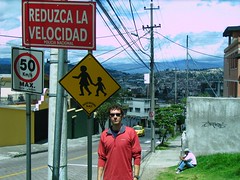Ecuador Travelogue (part 2)
Mindo’s a funny place. It’s pure Ecuatoriano – full of little tiendas on every block with free-roaming dogs that expertly dodge trucks that carry fruta or pescado or dangerously-packed construction equipment. And though not untouched by the corporate world, it’s still free of McDonald’s and Kentucky Fried Chicken and peanut butter. But as with all pueblos turisticos in Ecuador, there’s a rise in Internet cafes and adventure tourism. And it’s in those places that you see the most gringo influence. The most fluent English speakers and the most Americanized young men – emulating the X-Games and Jackass ethos we export abroad – run these establishments. And they look to be doing well. It’s ironic that gringo tourists flock to the gringo-ized Ecuador. But alas. It’s true.
Even we were drawn to the canopy zip lines advertised all over town. On Thursday, we rode/walked our piece of crap rented bicicletas up the mountainside to the original canopy adventure, called simply Canopy Adventure. We were the only customers. Two guias went with us.
What you do is you get onto a raised platform, where they strap you onto a steel cable and give you some quick safety instructions. Then they tell you to sit on your harness, cross your legs at the ankles, and hold on to the straps that are attached to the cable. And away you go, zipping above the cloud forest valley. My guide was kind of a grumpy jerk; Eileen’s was much more gregarious and nice. But it was fun either way.
The course consists of 13 cables, some freaky high up and others mas tranquilo. On some of them, you can opt to do the superman or the mariposa, both of which require a tandem trip with el guia. For the superman, you hook the backside of your harness onto the cable with a safety running to your guide. Then you basically fly horizontally through the air, face first toward the next platform. For the mariposa, you sit on your harness facing your guide and once you take off, he flips you upside down and holds onto your legs. I liked the mariposa a lot, but it was definitely freaky to see the sky below you and the canopy above.
Our return to Quito was in the standard bus, which travels through so many switchbacks that I had to put my head between my legs – or at least get close to doing so. There wasn’t actually enough leg room to bend over all the way. But I survived anyway.

